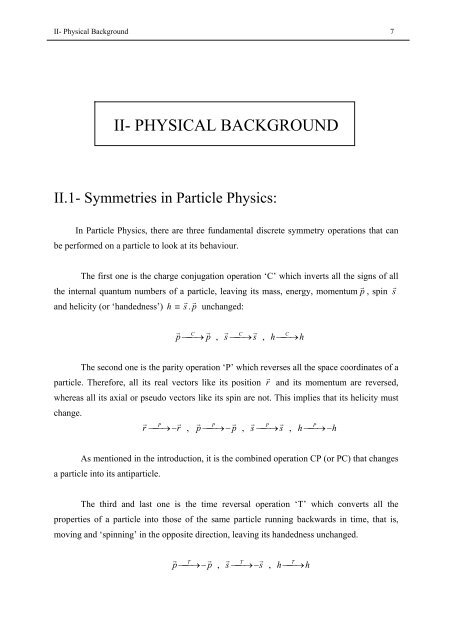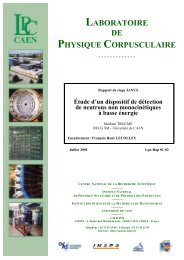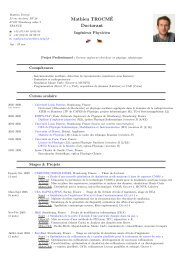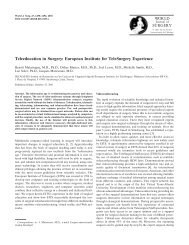Rare B meson decays - mathieu trocmé
Rare B meson decays - mathieu trocmé
Rare B meson decays - mathieu trocmé
Create successful ePaper yourself
Turn your PDF publications into a flip-book with our unique Google optimized e-Paper software.
II- Physical Background 7<br />
II- PHYSICAL BACKGROUND<br />
II.1- Symmetries in Particle Physics:<br />
In Particle Physics, there are three fundamental discrete symmetry operations that can<br />
be performed on a particle to look at its behaviour.<br />
The first one is the charge conjugation operation ‘C’ which inverts all the signs of all<br />
the internal quantum numbers of a particle, leaving its mass, energy, momentum p r , spin s r<br />
r r<br />
and helicity (or ‘handedness’) h ≡ s . p unchanged:<br />
r C r r C r<br />
p ⎯ ⎯→ p , s ⎯⎯→<br />
s ,<br />
C<br />
h ⎯⎯→<br />
h<br />
The second one is the parity operation ‘P’ which reverses all the space coordinates of a<br />
particle. Therefore, all its real vectors like its position r and its momentum are reversed,<br />
whereas all its axial or pseudo vectors like its spin are not. This implies that its helicity must<br />
change.<br />
r P r r P r r P r<br />
P<br />
r ⎯ ⎯→ −r<br />
, p ⎯⎯→<br />
− p , s ⎯⎯→<br />
s , h ⎯⎯→<br />
−h<br />
As mentioned in the introduction, it is the combined operation CP (or PC) that changes<br />
a particle into its antiparticle.<br />
The third and last one is the time reversal operation ‘T’ which converts all the<br />
properties of a particle into those of the same particle running backwards in time, that is,<br />
moving and ‘spinning’ in the opposite direction, leaving its handedness unchanged.<br />
r<br />
T r r T r<br />
p ⎯ ⎯→ − p , s ⎯⎯→<br />
−s<br />
,<br />
T<br />
h ⎯⎯→<br />
h






